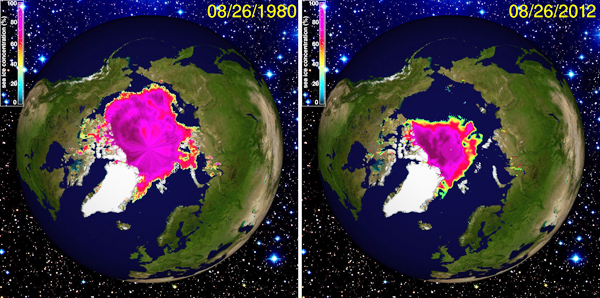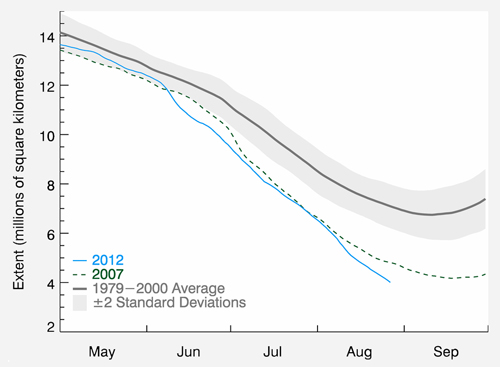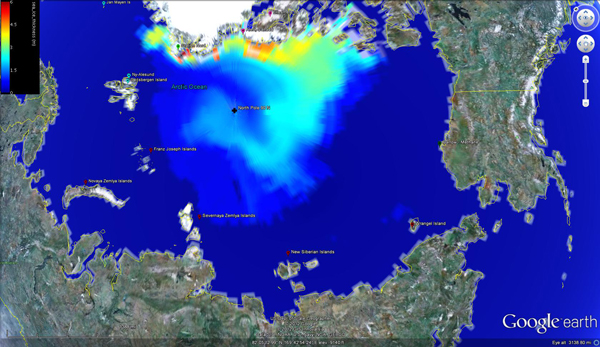As a warming Arctic sets new records, there’s new evidence that its impact is felt far to the south. [4 September 2012 | Peter Boyer]

Arctic sea ice extent on 26 August 1980 (left) compared with cover on same day in 2012. UNIVERSITY OF ILLINOIS: CRYOSPHERE TODAY
The place of dark winters, gothic tales and ghostly bears is playing on our minds again.
It’s as far from our Antipodean lives as it’s possible to get on Earth, but the Arctic looms large in the future of all of us. What’s happening there right now has the scientific world abuzz.
A week ago ice research centres in the US, the UK and Germany released data indicating that with the peak of summer melting still three weeks away, melting of sea ice in the Arctic Ocean is breaking all records.
This northern summer, the Arctic Ocean’s blanket of sea ice is smaller than we’ve ever known, tracking well below previous record lows in 2007 and 2011. Once, Russian supertankers needed accompanying icebreakers for at least part of their Arctic journey across the north of Siberia; now it’s open water all the way from the Atlantic to the Pacific.
Most people know very little about polar regions. We know there’s ice there, but on the whole we’re pretty ignorant as to how much of it there is, whether it’s sitting on land or floating on the sea, how it moves, forms and decays, and what it says about our climate.

Area of Arctic Ocean with at least 15 per cent sea ice cover: Data for 2012 (blue line) compared with 2007 (green) and the average for 1979 to 2000 (grey line with standard deviations – shaded area). DATA: US NATIONAL SNOW AND ICE DATA CENTER
As a result we put too little store on how polar regions might affect our lives. For instance, research published last week looking at climate indicators in Antarctic ice cores going back a millennium showed that eastern Australian rainfall since 1920 has been well below the 1000-year average.
Dr Tessa Vance, of Hobart’s Antarctic Climate and Ecosystems CRC, and others have studied wind-borne sea salt captured in past snow deposits obtained from drill cores on Law Dome, a coastal ice mound in Antarctica.
Low salt levels in the ice cores indicate the presence of an El Nino weather pattern to the north, causing drying in eastern Australia. The 1000-year proxy record, the longest available for Australian weather, also indicates a second long dry spell about 800 years ago.
Which is to say, the ice has much to tell us, but its messages aren’t always getting through. We train scientists to study these extreme environments, but all too often what they report back gets lost in translation. What’s worse, much media coverage about polar ice is mired in misconception.
Last April, for instance, my colleague Piers Akerman deduced from US National Snow and Ice Data Center records that ice cover over many parts of the Arctic Ocean was above average, citing ice weather data and anecdotal fishing information to support his claim that there was no Arctic sea ice decline.
He’s mistaken. Large areas of Arctic sea ice are built up over years to thicknesses of many metres, and remain in place through the summer. The ice he was referring to is seasonal ice, forming each autumn as soon as it gets cold enough and decaying in stages through spring.
Like most Antarctic sea ice, which virtually disappears in summer, Arctic seasonal ice doesn’t tell us anything about the overall, long-term state of the sea ice. For that, scientists look at the volume of multi-year ice. It’s here that the true magnitude of this summer’s melt comes into sharp focus.

Image for August 28, 2012, showing thickness of Arctic Ocean sea ice — most of it less than 3 metres thick. DATA: NATIONAL CENTRE FOR OCEAN FORECASTING (UK), GROUP FOR HIGH RESOLUTION SEA SURFACE TEMPERATURE. IMAGE: APOCALYPSE4REAL
US and UK records show current thinning of Arctic sea ice on a scale previously unknown. Multi-year ice around the North Pole, normally three or four metres thick, is now down to a metre or so. Thicker ice — but none more than about five metres thick — is confined to a small area to the north of Greenland and the Canadian archipelago.
This summer’s record-breaking melt has led some scientists to predict an ice-free late summer for the Arctic Ocean within a decade. The Intergovernmental Panel on Climate Change said in its 2007 report that some models showed such a thing occurring by 2100. So much for an “alarmist” IPCC!
The consequences of a warming Arctic Ocean are many and widespread. The ocean warming is accelerating as heat-reflecting ice is lost. A warmer ocean lapping the shores of Greenland is already helping to increase the decay rate of that island’s big ice sheet. (The same phenomenon is causing a lot of anxiety over the stability of the West Antarctic ice sheet.) Unlike melting sea ice, which doesn’t affect sea level, accelerated loss from Greenland’s ice sheet will mean an increased rate of sea level rise.
A warmer Arctic Ocean with thinner, sparser sea ice also has disturbing implications for weather across the whole Northern Hemisphere, revealed in a 2012 study of North American weather patterns. This research, led by Professor Jennifer Francis, a meteorologist at Rutgers University, New Jersey, has found a warmer Arctic is causing weather conditions in more temperate parts to persist for longer periods, increasing the probability of cold spells, heat waves, prolonged snowfall and drought.
The strength of the jet stream winds controlling weather across the Northern Hemisphere is determined by the difference in temperature between Arctic and temperate latitudes. The study found that a warmer Arctic Ocean was effectively reducing this temperature difference, causing the jet stream to weaken.
As it has weakened, the jet stream has become contorted into a wave-like pattern, forming large, slow-moving ridges and troughs extending from the Arctic far to the south. In the United States this pattern is linked to extended droughts, heatwaves and extreme cold snaps in recent years. It was a likely factor in the Russian heatwave that set the Moscow countryside ablaze two years ago.
John Ralston Saul, the Canadian philosopher who was in Hobart last week, recounted at the 2010 Melbourne Writers’ Festival how, in numerous flights over many years, he’s observed his country’s shrinking cover of mountain ice, or glaciers.
And yet, he said, we still decline to act: “We are in a kind of self-destructive intellectualism, which prevents us from looking at what any fool could look at and say, gosh, there may be a problem here. Maybe we should actually do something as opposed to negotiating about doing something.”
An excellent suggestion. Why isn’t it top of the bill for the US presidential election?
